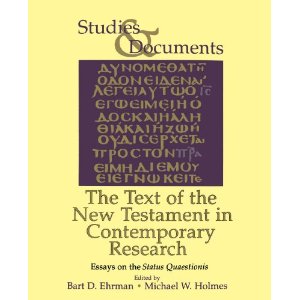 |
Book Review by WordExplain |
"When this letter is read among you, have it also read in the church of the Laodiceans; and you, for your part read my letter that is coming from Laodicea." Colossians 4:16 |
                   |
The Text of the New Testament in
Contemporary Research:
Essays on the Status Quaestionis
Allow
me first to confess that I am not qualified to review this book. This
is a technical book by experts in their field. Much of the book is,
frankly, over my head. Nevertheless, I will give my perspective.
Let me also reveal my own beliefs. I believe that all Scripture is God-breathed. That is not a question for me. I also believe that the text of the New Testament, as it has been hand-copied and passed down to us, is somewhat less certain. I say that because there are a great many differences, most of them very small differences, between the extant manuscripts (MSS). The discipline of textual criticism is the discipline of recovering, as nearly as possible, the text of the original autographs (writings by men like Peter and Paul). I also believe in God's sovereign preservation of the text. But in His Sovereignty, He has not preserved it in a neatly, perfectly-wrapped package. He has preserved the New Testament in about 6,000 MSS, none of which perfectly agrees with any other. That is not a neat and tidy package. But it is the real package God preserved for us. Evidently he meant us to use our heads and try to reconstruct the original text as best we can. My purpose in purchasing this text was primarily to gain some certainty in ascertaining the original text of the Greek New Testament, or at least its text type. I was disappointed in my endeavor. But at least I know better what the issues are. I gained more certainty in what the original text type most likely was not - the Byzantine (Byz), or Majority Text. The odds are just too much against it. Daniel B. Wallace wrote chapter 19, The Majority Text Theory: History, Methods, and Critique (pp. 297 ff.). Proponents of the Byz text type begin from a doctrinal, rather than an evidential basis (aside from the numbers of MSS, of course).. Doctrinal Underpinnings of the Traditional Text Theory. They believe the doctrine of inspiration demands preservation. And for them, God has preserved the Byz text as witnessed by its overwhelming preponderance. To this faith-based position Wallace makes four counter-observations. (1) "First, the driving force behind this theological formulation is an undifferentiated need for certainty." (2) "Second, ironically, as much effort as Majority text advocates expend against subjectivity and the use of human reason, their entire doctrinal basis is founded on what they think God must have done." (3) Third, this fideistic [faith-based] formula violates all known historical data." Here Wallace remarks that the Byz text did not even become a majority until the ninth century, and even at that, there are nearly twice as many Latin MSS as Greek, with none of the Latin MSS having readings that correlate with the Byz text type, to his knowledge. (4) "Fourth, this doctrinal stance also lacks a sound exegetical basis." External Evidence. (1) The strongest argument for the Majority text theory is its preponderance in numbers. But that is where the numbers argument stops. The earliest known MSS are the papyri. To date, nearly one hundred have been discovered, but none of them are of the Byz text type. The Majority text did not become a majority until the ninth century. And "as far as the extant witnesses reveal, the Majority text did not exist in the first four centuries." The monotonous response of the Byz advocates is that the Byz copies were worn out because of great use. To me, the reader, that carries about as much weight as the proverbial "The dog ate my homework." It is remotely possible, but highly unlikely. As Wallace asks, if they were worn out, how did they ever become a majority? The facts are that the early Greek MSS are not Byzantine. (2) Not only that, but the early versions (translations from Greek into other languages) also do not reveal a Byz text type until the Gothic version at the end of the fourth century. The Coptic, Ethiopic, Latin, and Syriac versions - all non-Byzantine - antedate the fourth century and come from various regions around the Mediterranean." (3) Furthermore, the Church Fathers, in their quotations of the Greek New Testament do not use the Byzantine text form.. "The earliest Church Father to use the Byzantine text was Asterius, a fourth-century writer from Antioch." So what was the original text type? The answer to that apparently is that we do not know for certain. A great many textual critics believe the Alexandrian text type was the original. But surprisingly (to me) there are those who believe the Western text type was original. Moises Silva, who wrote chapter 18, Modern Critical Editions and Apparatuses of the Greek New Testament (pp. 283 ff.) pointed out that the text of Acts has both Alexandrian and "Western" texts within it (p. 293). Which is the original? Michael Homes, co-editor, wrote chapter 21, Reasoned Eclecticism in New Testament Textual Criticism (pp. 336 ff.), made an interesting concession. He conceded that reasoned eclectics do not have an adequate or coherent view of the history of the text (p. 352). One can have a theory of which is the original text type, but until one can put together a history of the text that adequately explains how all or most of the individual pieces fit together in a composite whole, the case will be unconvincing, and uncertainty will prevail. In my own mind, I liken the MSS of the Greek NT to be a 6,000-piece jigsaw puzzle. Many of the border pieces appear to be Alexandrian, and a number appear to be "Western." There are many pieces that can be grouped together as being similar in shade (Byzantine). But as far as being able to put the whole puzzle together to be able to exhibit a clear picture of the history of the NT text, we are unable to do so. After reading Holmes' chapter, I came away with the impression that we are not really even close to recovering the original autographs of the New Testament. The whole book was written by different contributors. And clearly there are some visibly opposing ideas in methodology and conclusions by the contributors. The benefit is the widely-based perspective given, but the disadvantage is lack of coherence in theory and methodology. Computers? Robert A. Kraft wrote chapter 17, The Use of Computers in New Testament Textual Criticism" (pp. 268 ff.). I was curious to note the slowness and reluctance with which the "elites" of the textual criticism discipline have employed the use of computers. One report claimed that it would take "the resources of 200-man-years" "to encode the available manuscripts by hand," and the development of suitable automatic scanning capabilities for that task "would require something like 20 man-years!" (p. 269). The textual data is so massive that critics have carefully examined only sample passages (with and without computers). But to correlate the date adequately, all the manuscripts for a given book of the Bible must be quantified. Apparently there is an incredible amount of work yet to be done with computers in the area of textual criticism. My over-all impression, reading this book, is that we are a long ways from arriving at certainty in pin-pointing the text of the original autographs. Like the proponents of the Byz text theory, I crave certainty. In perspective, 85% of the text of the NT is not in question. And we can have reasonable certainty on much of the remainder. But total certainty is not possible, not even for the proponents of the Byz text. Like them, I believe in the Sovereign preservation of God in the New Testament. I just do not believe that the Byzantine text best exemplifies what that original text was. God could have left us a New Testament with no errors whatever in the copying process. He did not choose to do that. Every manuscript differs from every other manuscript in the copying process. God in His Sovereignty chose to leave us a Bible that had many errors in the copying process. It is up to us to study hard and determine the best text of the New Testament as best we can. What God has preserved is nearly 6,000 MSS all differing from one another. Let us keep working hard to put the pieces of the puzzle together in a convincing and coherent whole. One final thought: I am far more concerned, not about the relative uncertainty of certain texts, but rather about whether I am adequately following and obeying that which has clearly been revealed. I think God will hold me accountable for what I know but have not practiced rather than for not being absolutely settled on every single word of Scripture as compared to the original text. Contact: jbartsch@wordexplain.com
Published June 8, 2011
Updated June 22, 2015 |
